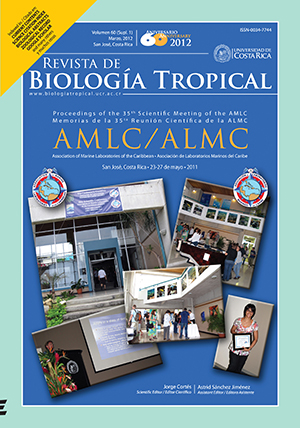Abstract
The Queen Conch (Strombus gigas Linnaeus, 1758) is a species of economic importance in the Caribbean Sea, which, in the 1980’s represented the second fishery after de spiny lobster, reason that is currently in a state of overfishing. In order to determine the larval abundance variation during the reproductive season, four locations of the Mexican Caribbean “MC” (Mexico: Puerto Morelos, Sian Ka’an, Mahahual; Belize: San Pedro) were sampled. Monthly, from May to October 2008, planktonic net drags (300μm) were carried out at each location. Temperature (°C), salinity (ppm) and dissolved oxygen (mg L-1) were recorded for each site. A mean larval density of 0.34±0.87 (larvae 10 m-3) was registered between locations, with a peak in August and September (0.82±1.00 and 0.76±1.68 larvae 10m-3, respectively). The larval density was 60% correlated with salinity (r=0.6063, p<0.05). A one-way ANOVA showed significant statistical larval density in time (p<0.05) and space (p<0.05), where Puerto Morelos displayed the higher records during the study (0.54±1.49 larvae 10m-3). An average larval size of 332.44±59.66μm was recorded. Larval sizes differed significantly between locations (p<0.05), but not considering months (p>0.05). A 100% of the captured larvae correspond to stage I, showing local reproductive activity, that might indicate the sampled sites in the MC are a source of larvae to S. gigasComments
Downloads
Download data is not yet available.






